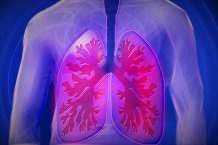Feb 5 2019
Graphene, a wonder material, could be the solution to unraveling the next generation of advanced, early-stage lung cancer diagnosis.
 The quest to discover viable new techniques to accurately detect early-stage lung cancer is one of the greatest global health care challenges. (Image credit: University of Exeter)
The quest to discover viable new techniques to accurately detect early-stage lung cancer is one of the greatest global health care challenges. (Image credit: University of Exeter)
A new method has been formulated by University of Exeter researchers to create an extremely sensitive graphene biosensor that can detect molecules of very common lung cancer biomarkers.
The new biosensor design could transform current electronic nose (e-nose) devices, that identify particular components of a particular vapor mixture—for instance a person’s breath—and examines its chemical composition to identify the cause.
The research team believes the recently developed device exhibits the potential to identify precise lung cancer markers at the earliest possible stage, in a reusable and convenient way, thus making it both economical and extremely advantageous for health service providers around the world.
The study is reported in the Royal Society of Chemistry’s peer-reviewed journal Nanoscale.
The new biosensors which we have developed show that graphene has significant potential for use as an electrode in e-nose devices. For the first time, we have shown that with suitable patterning graphene can be used as a specific, selective and sensitive detector for biomarkers. We believe that with further development of our devices, a cheap, reusable and accurate breath test for early-stage detection of lung cancer can become a reality.
Ben Hogan, Postgraduate Researcher and Study Co-Author, University of Exeter
The mission to discover viable new methods to exactly detect early-stage lung cancer is one of the most crucial global healthcare challenges. Although it is one of the most prevalent and aggressive cancers, killing about 1.4 million people around the world each year, the lack of clinical indicators in its early stages means a lot of patients are not diagnosed until the latter stage, which makes it hard to treat.
As a result of the uncontrollable nature of the abnormal cancer cells, while they start in one or both lungs, they are susceptible to spread to other parts of the body quickly.
There are presently no inexpensive, simple, or commonly available screening approaches for early diagnosis of lung cancer. However, for the new study, the Exeter team explored whether graphene could form the foundation for a new, improved biosensor device.
Using multi-layered graphene, the team proposes that present-day e-nose devices—which incorporate electronic sensors with mechanisms for pattern recognition, such as a neural network—could transform breath diagnostic methods.
With the patterned multi-layered graphene electrodes, the researchers were able to demonstrate greater sensing capabilities for three of the most common lung-cancer biomarkers—isopropanol, ethanol, and acetone—across a variety of different concentrations.
The researchers trust this could be the primary step towards developing new, enhanced, and economical e-nose devices that could deliver the earliest possible lung-cancer diagnosis.